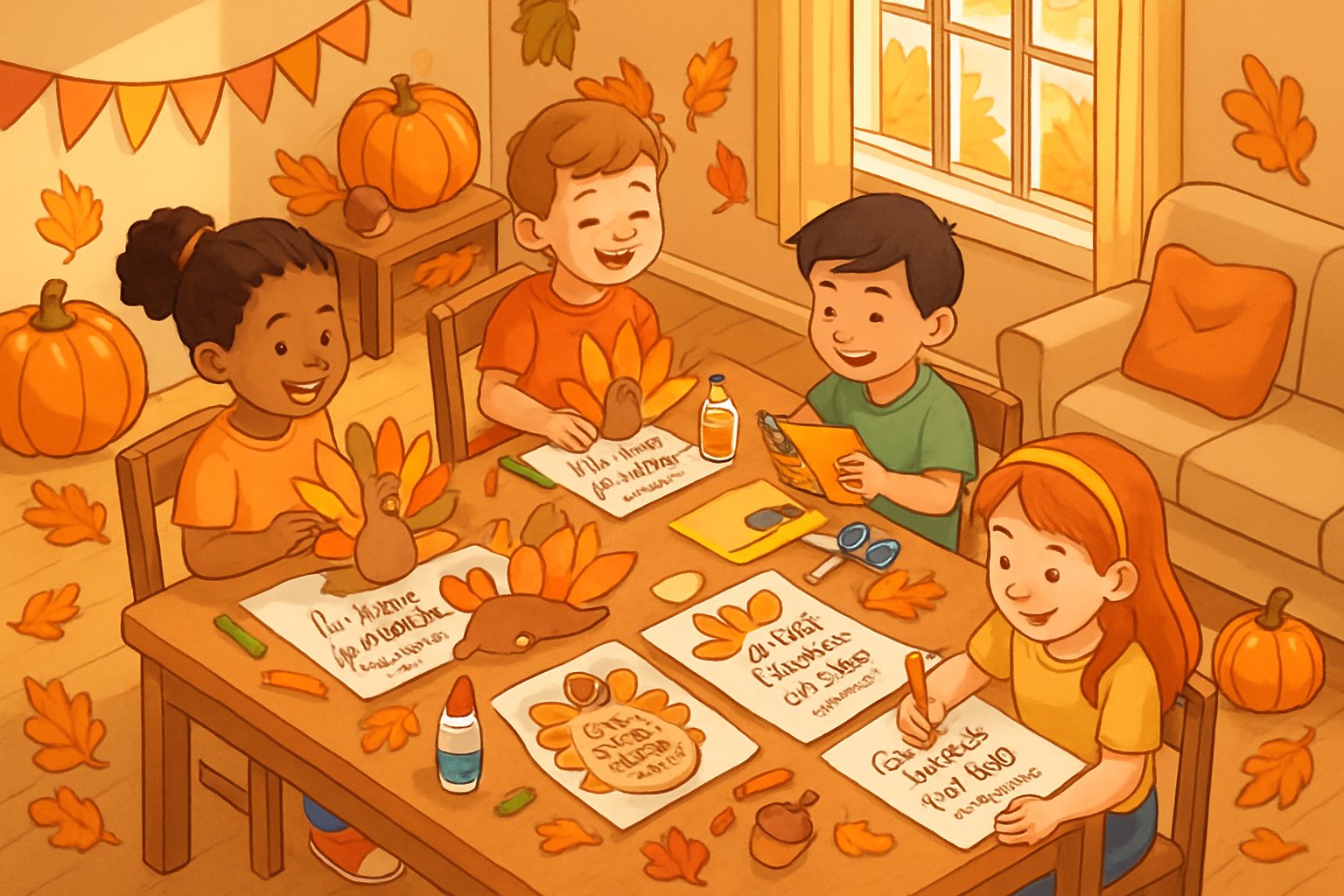Thanksgiving is a great time to help kids learn about gratitude and connect with biblical principles. During this season, you can invite children to discover the deeper meaning of thankfulness through activities that bring Scripture to life in fun and memorable ways.
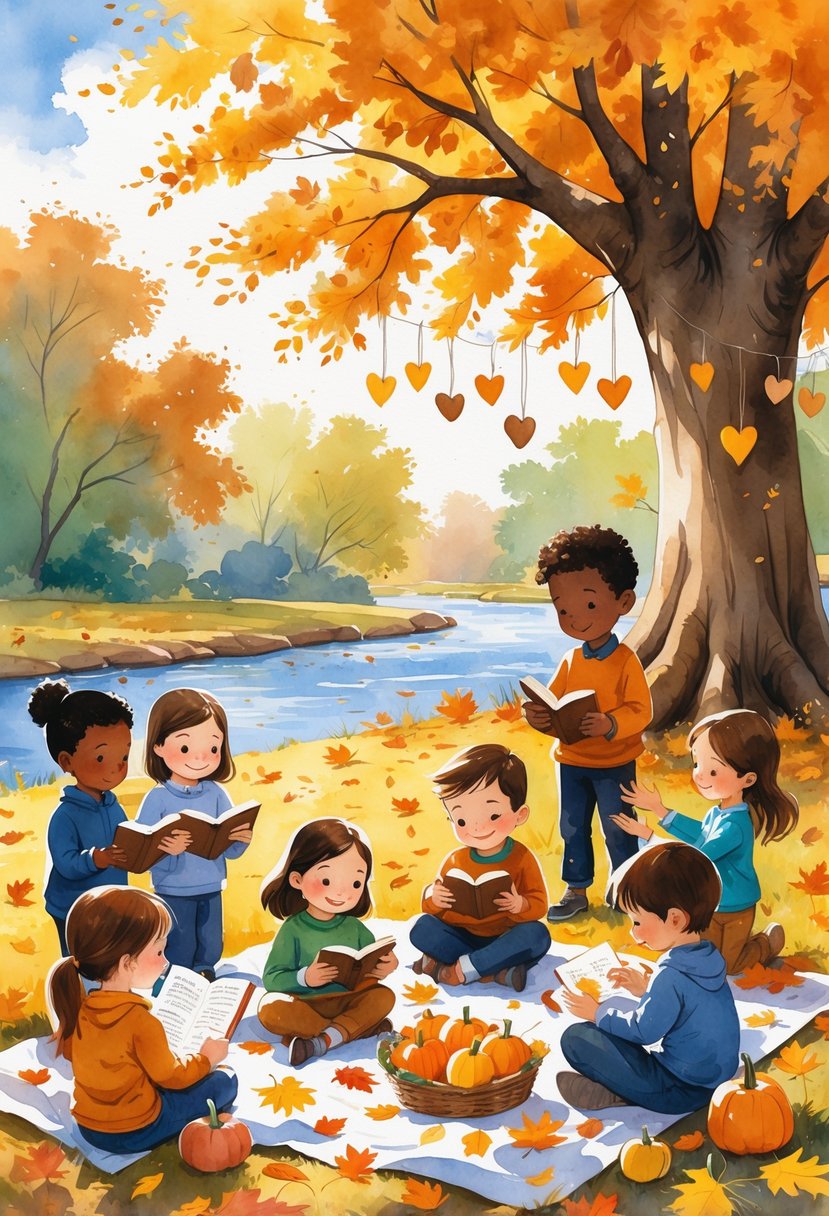
These Bible-based Thanksgiving activities blend crafts, interactive lessons, and thoughtful discussions to help kids understand God’s blessings and grow grateful hearts.
You’ll find activities that explore key stories about thankfulness, hands-on crafts that make lessons stick, and easy ways to practice gratitude all year long.
Luke 17:11-17 Thankful Lepers Bible Lesson
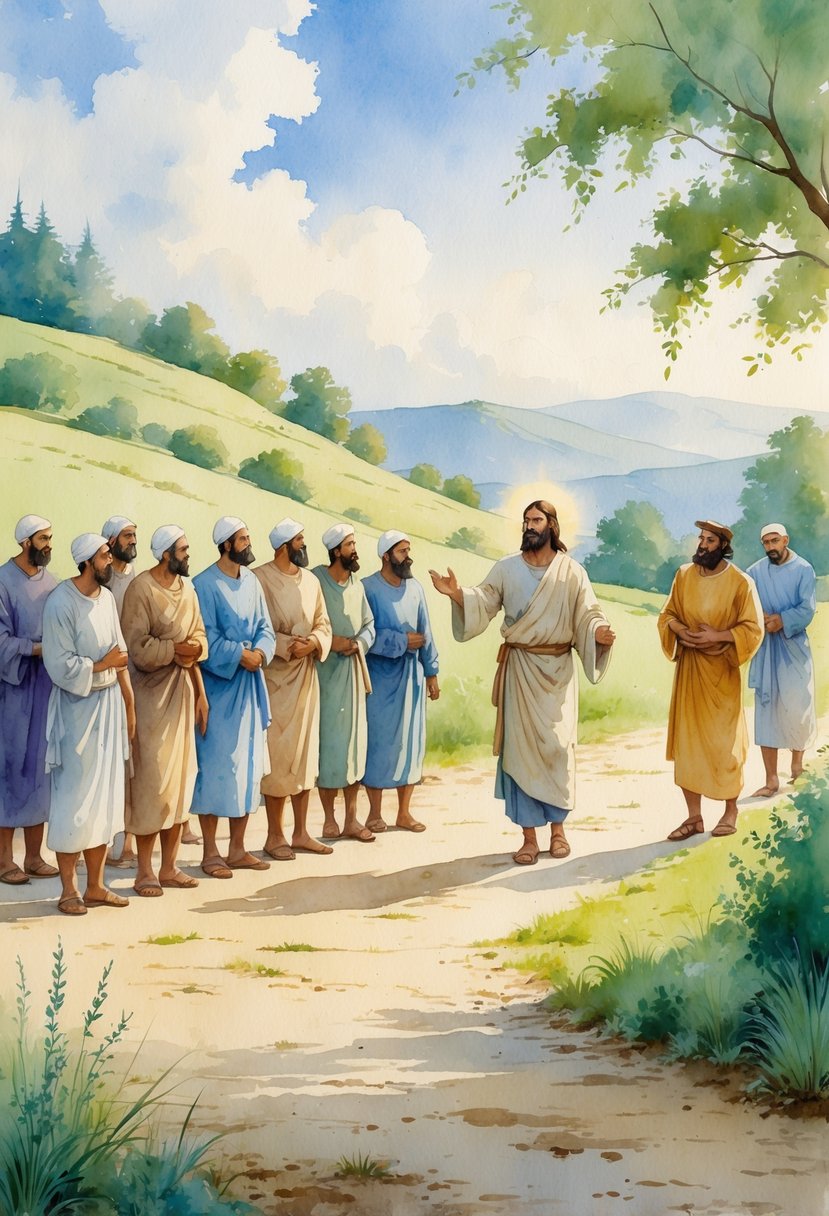
This Bible lesson about Jesus healing ten lepers shows kids what gratitude looks like. The story in Luke 17:11-17 tells how Jesus healed ten men with leprosy.
Explain to kids that lepers had a contagious skin disease and had to live away from their families. When people saw them, the lepers shouted “unclean” as a warning.
The ten lepers called out to Jesus from a distance, asking for help. Jesus told them, “Go show yourselves to the priests,” and as they walked away, all ten men found themselves healed.
But only one leper came back to thank Jesus. He fell at Jesus’s feet, praising God for his healing.
Jesus wondered aloud where the other nine were and why only one returned to give thanks. You can use this printable Bible lesson to help kids see why saying thank you matters.
Ask children to remember times they forgot to say thank you. Show them that God wants us to have thankful hearts.
Try thankful leper activities like role-playing or having kids draw pictures of things they want to thank God for.
This Bible story encourages children to express gratitude right away. When God blesses us, we can respond with thanksgiving, just like the thankful leper did.
Gratitude Craft: Thankful Handprint Wreath
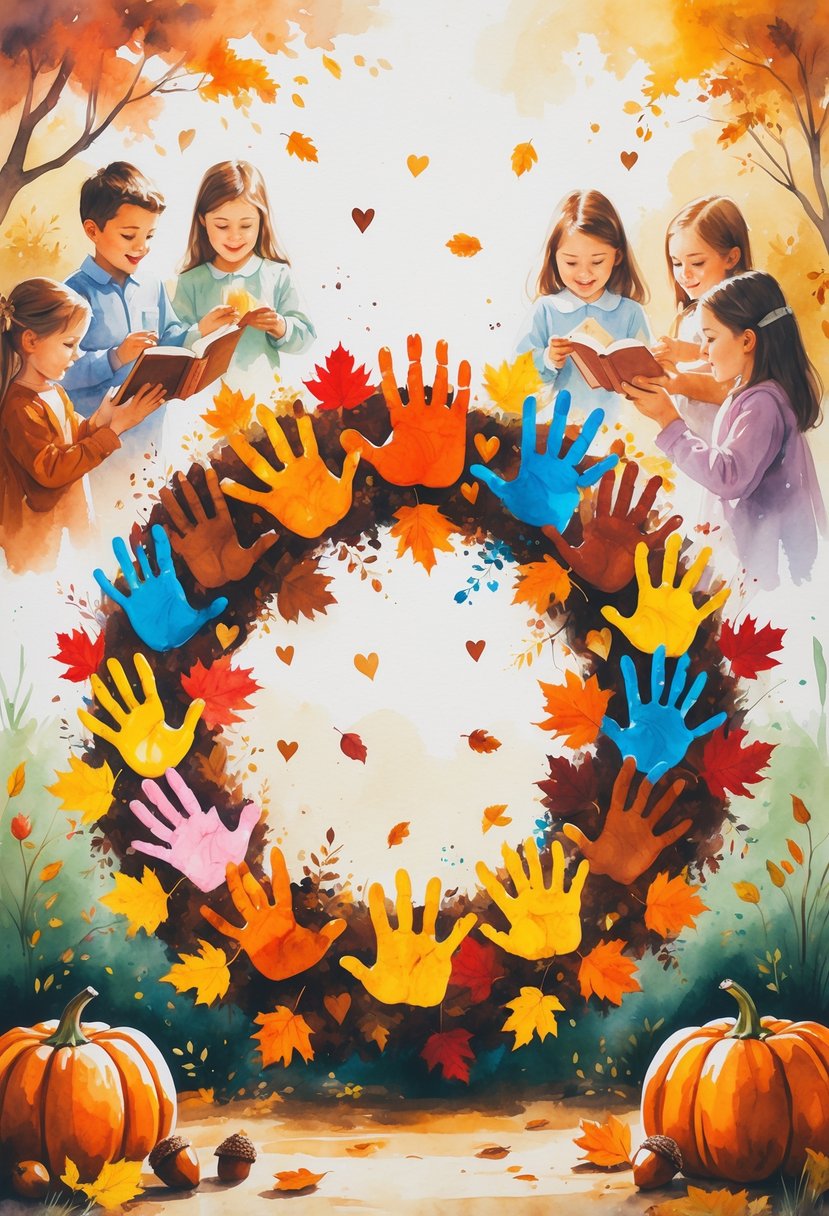
Try making a handprint wreath that mixes creativity with lessons on biblical gratitude. Kids can make a festive decoration and reflect on God’s blessings at the same time.
Trace each child’s hand on colorful construction paper. Cut out several handprints using autumn colors like orange, red, yellow, and brown.
Arrange the handprints in a circle on a piece of cardboard, overlapping them to form a wreath. Glue them in place so the wreath holds together.
On each handprint, write something you’re thankful for. Add Bible verses about gratitude, like Psalm 100:4 or 1 Thessalonians 5:18.
Put a Scripture reference in the center—maybe Colossians 3:15: “Let the peace of Christ rule in your hearts, since as members of one body you were called to peace. And be thankful.”
Decorate the edges with paper leaves or ribbon. Toss in some glitter or stickers if your kids want to jazz it up.
This Christian gratitude wreath activity is great for Sunday school or family devotions. Each handprint stands for a personal blessing from God.
Hang the finished wreath somewhere everyone can see it. It becomes a daily reminder of God’s faithfulness and provision.
Kids love seeing their handprints in a group project. This craft helps them tie their creativity to spiritual growth and thankfulness.
The Turkey Who Invited Everyone to Dinner Story & Activity
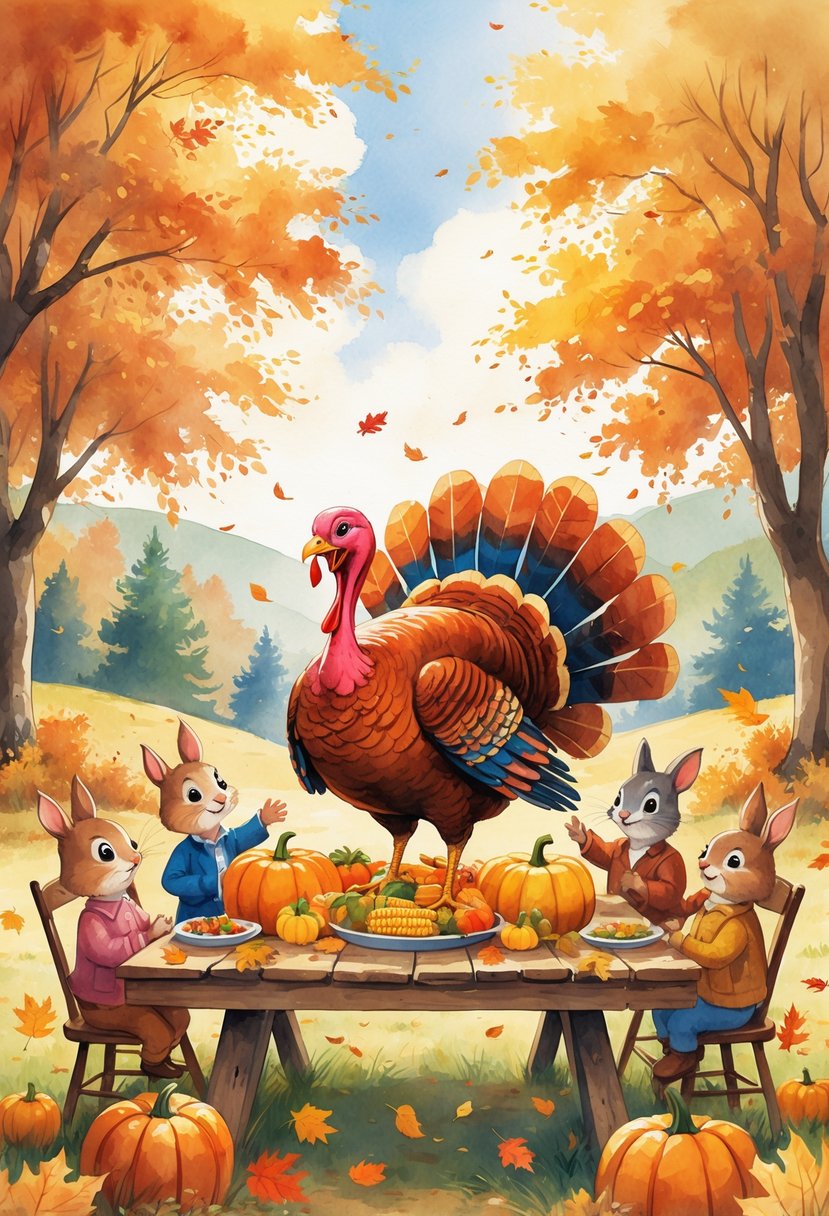
This Thanksgiving Bible lesson for preschoolers uses a story to teach kindness and sharing. Hebrews 13:16 encourages us to do good and share with others.
The story follows a generous turkey who decides to invite everyone in the forest to his Thanksgiving dinner. Instead of keeping all the food, the turkey shares with his neighbors.
Use this story to help kids understand hospitality and generosity. The turkey shows how we can treat others with kindness and welcome them in.
The lesson includes a short Bible story that’s easy for little ones to follow. You’ll also find crafts, snacks, and games that reinforce the message of sharing.
A Bible song for kids goes along with the lesson. The catchy tune helps kids remember the lesson about inviting others and sharing God’s love.
This activity fits well in Sunday school, children’s church, or homeschool. Adjust the story and activities for your group’s age and attention span.
Printable materials make it easy for busy parents and teachers. You get everything you need in one place, which honestly is a lifesaver sometimes.
Bible Verse Coloring Pages on Thankfulness

Bible verse coloring pages let kids get creative while learning scripture about gratitude. These activities keep little hands busy and minds focused on thankfulness.
Many Christian Thanksgiving coloring pages feature crosses, praying hands, and autumn scenes. Kids can color turkeys, pumpkins, and leaves while reading verses about thankfulness.
Free Thanksgiving coloring pages with Bible verses give you more than just coloring—they help kids memorize scripture while working on their fine motor skills.
You can find Bible verse coloring pages with space for kids to write what they’re thankful for. Combining coloring, reading, and writing really helps gratitude lessons stick.
Thanksgiving activity pages with Bible verses can spark conversations about the first Thanksgiving. The cute graphics make it easier to talk about both history and faith.
These coloring activities work for Sunday school or family time at home. Sunday school Thanksgiving coloring pages keep kids engaged while waiting for holiday meals.
Christian Thanksgiving coloring pages mix faith and fall fun with thankful-themed pictures. Kids can enjoy drawing and pick up important Bible verses about gratitude along the way.
The mix of art and scripture helps kids remember thankfulness long after Thanksgiving. These coloring pages with Bible verses point children toward Christ during the holiday season.
Jesus Heals 10 Lepers Sunday School Lesson
This Bible lesson from Luke 17:11-19 shows kids what gratitude looks like through Jesus’s miracle. Ten men with leprosy asked Jesus for healing as he traveled between Samaria and Galilee.
Jesus told the men, “Go show yourselves to the priest,” following the Old Testament law. As they walked away, all ten men realized they’d been healed.
Only one man—a Samaritan, actually—came back to thank Jesus for the miracle. The others just went on their way.
You can use this story to help kids see why expressing gratitude matters. The lesson highlights Jesus’s healing power and how people react differently to God’s blessings.
Create interactive activities like true-or-false games where kids answer questions about the story. They’ll remember more if they’re having fun.
Try crafts that represent the ten lepers or have kids make thank you cards. These hands-on activities reinforce the thankfulness theme, which fits right in with Thanksgiving.
Let children act out the story with role-playing. They can pretend to be the grateful Samaritan or the nine who forgot to come back.
Printable lesson plans come with activities, crafts, and coloring pages. You’ll find versions for different ages, so everyone can join in.
Talk with kids about what they’re thankful for in their own lives. Connect the Samaritan’s gratitude to ways they can appreciate God’s blessings today.
Thanksgiving Prayer Time with Kids
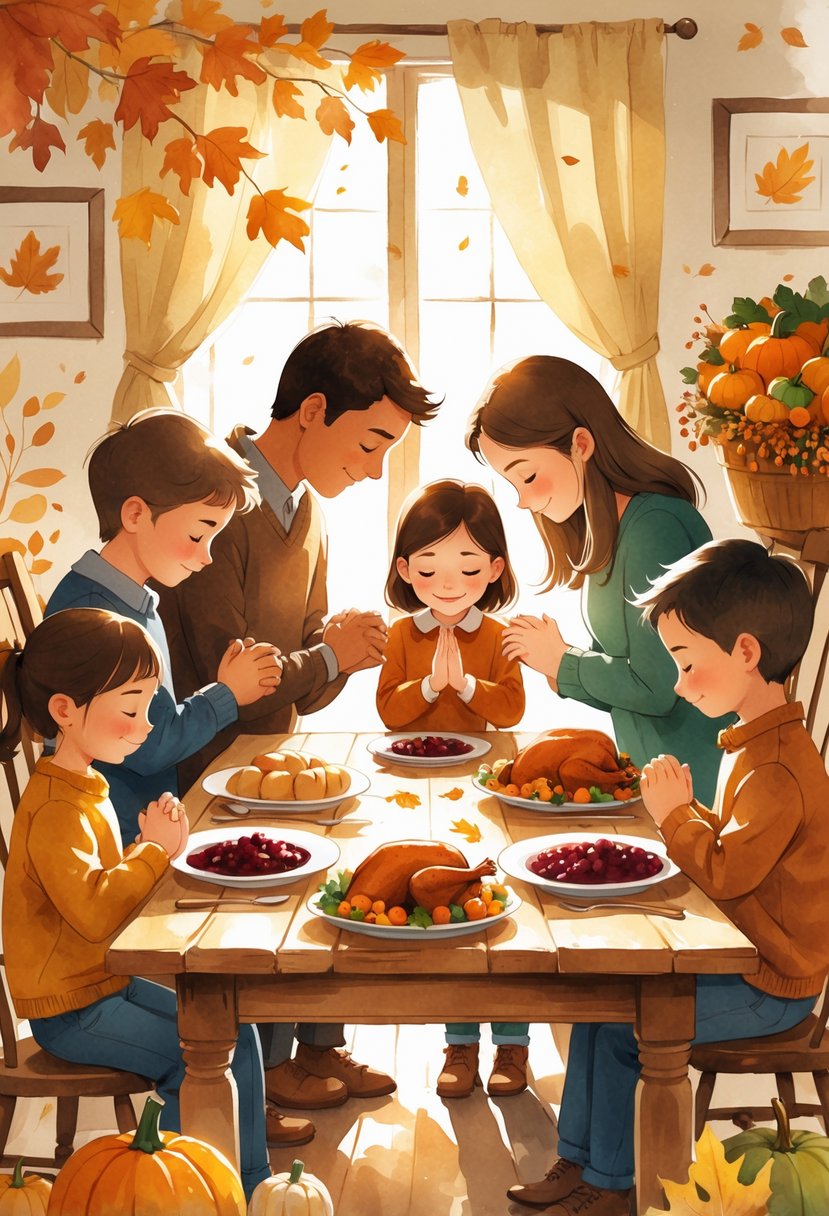
Thanksgiving is such a good time to help kids learn gratitude. Prayer can really open up those meaningful moments that connect children with God and let them express thanks in their own way.
Try starting with simple sentence prayers—something even toddlers can follow. Let each child finish the phrase, “Thank you God for…” and see what they come up with.
Gather everyone into a prayer circle and hold hands. That little bit of physical connection can make kids feel like they’re really part of something.
Use a basket filled with little objects that represent blessings—maybe a toy, a photo, or a leaf. Let each child pick one and pray about that specific gift.
Alternate lines during prayer, with you saying one and the children repeating it. This call-and-response style keeps everyone focused, especially the younger ones who might otherwise drift off.
Mix in Bible-based Thanksgiving activities that have interactive prayer. Try having kids stand up for things they’re thankful for—it’s a nice way to get them moving and thinking.
Write prayers together as a group. Let the kids offer ideas and jot their words down on a whiteboard or piece of paper.
Make prayer journals where kids can draw pictures of what they’re grateful for. During prayer time, they can share their drawings and talk about why those things matter to them.
Head outside for some nature prayers. Thank God for trees, flowers, birds—whatever catches their eye. Nature seems to make everything more real for kids.
Try faith-based Thanksgiving crafts like prayer wheels or gratitude trees. Let the kids spin the wheel or pick a leaf to guide their prayers—it’s playful and meaningful at the same time.
End with a group “Amen” that everyone can shout together. It sounds a little silly, but honestly, it makes the whole thing feel joyful and complete.
Thankful Tree Craft with Bible Verses
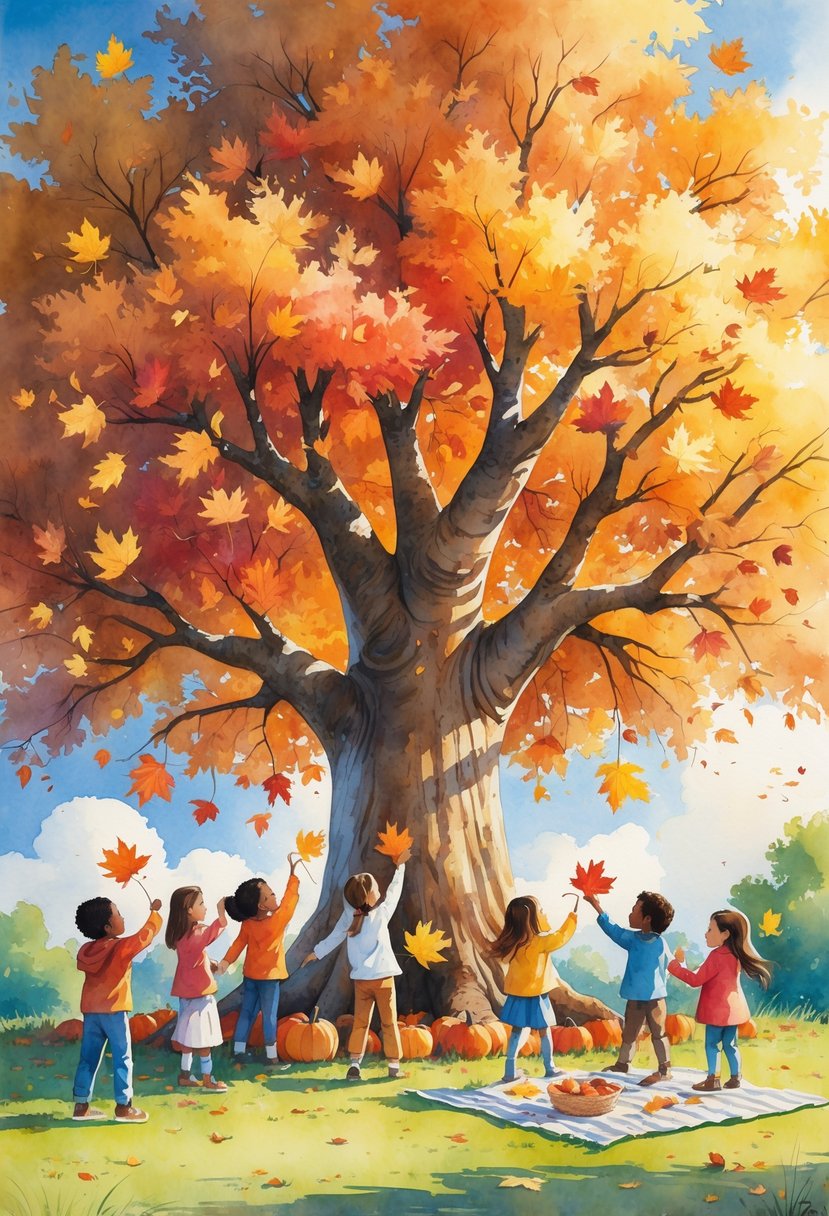
The thankful tree craft blends creativity and Scripture to help kids express gratitude in a hands-on way. You can make this Christ-centered Thanksgiving activity with just a few simple materials and some Bible verses about thankfulness.
Draw or print a big tree trunk and branches on brown paper. Or, if you’re feeling crafty, stick a real branch in a vase or jar for a 3D version.
Cut out leaves from construction paper in classic fall colors—red, orange, yellow, brown. Have plenty so each child can make a few thankful notes.
Write some Bible verses about gratitude on a few leaves before you start. Verses like Psalm 100:4, 1 Thessalonians 5:18, or Colossians 3:17 are always solid choices.
Hand out blank leaves and let each child write or draw what they’re thankful for. If they’re too young to write, let them dictate and you jot it down, or just let them draw pictures of their blessings.
Encourage kids to think of specific gifts from God. Family, pets, favorite foods, or even silly moments they’ve loved—anything that feels real to them.
After the leaves are finished, have each child share what they wrote before sticking them on the tree. It’s a sweet way to hear all the different things kids notice and appreciate.
Tape, glue, or tie the leaves to your tree. The finished craft ends up as this colorful reminder of God’s faithfulness and all the good things in your lives.
Display the thankful tree in your classroom or send it home so families can keep adding leaves through Thanksgiving. This Bible-based Thanksgiving printable activity works for Sunday school or at home.
Read Bible stories about gratitude while you work on the craft. Stories like the ten lepers or Jesus feeding the five thousand help drive home the importance of noticing and thanking God for His blessings.
Sharing and Kindness Lesson from Hebrews 13:16
Hebrews 13:16 says, “Do not neglect to do good and to share what you have, for such sacrifices are pleasing to God.” It’s the perfect verse for teaching kids about generosity, especially around Thanksgiving.
Try a sharing object lesson with grapes. Hand each child a bunch of grapes and encourage them to offer some to others in the group.
This hands-on lesson shows kids that sharing can be joyful for both the giver and the receiver. Grapes are a simple, concrete way to practice generosity without making it feel like a lecture.
Read The Turkey Who Invited Everyone to Dinner to younger kids. The story is fun and teaches about kindness and sharing through a narrative that actually sticks.
Show them The Puppy Who Shared His Bread, a sweet Bible story video for ages 3-6. It’s all about how sharing makes everyone happier and lines up with what God wants.
Talk about the difference between forced sharing and sharing from the heart. Ask the kids to remember times when they wanted to share, not just when someone told them to.
Give kids chances to do acts of kindness during Thanksgiving activities. Maybe they can write thank-you notes to helpers in the community or collect items for families who need a little extra this year.
This lesson highlights how selfless acts of kindness and generosity matter. Kids start to see that these choices make God happy and help their communities grow stronger.
Printable Thankfulness Journals for Kids
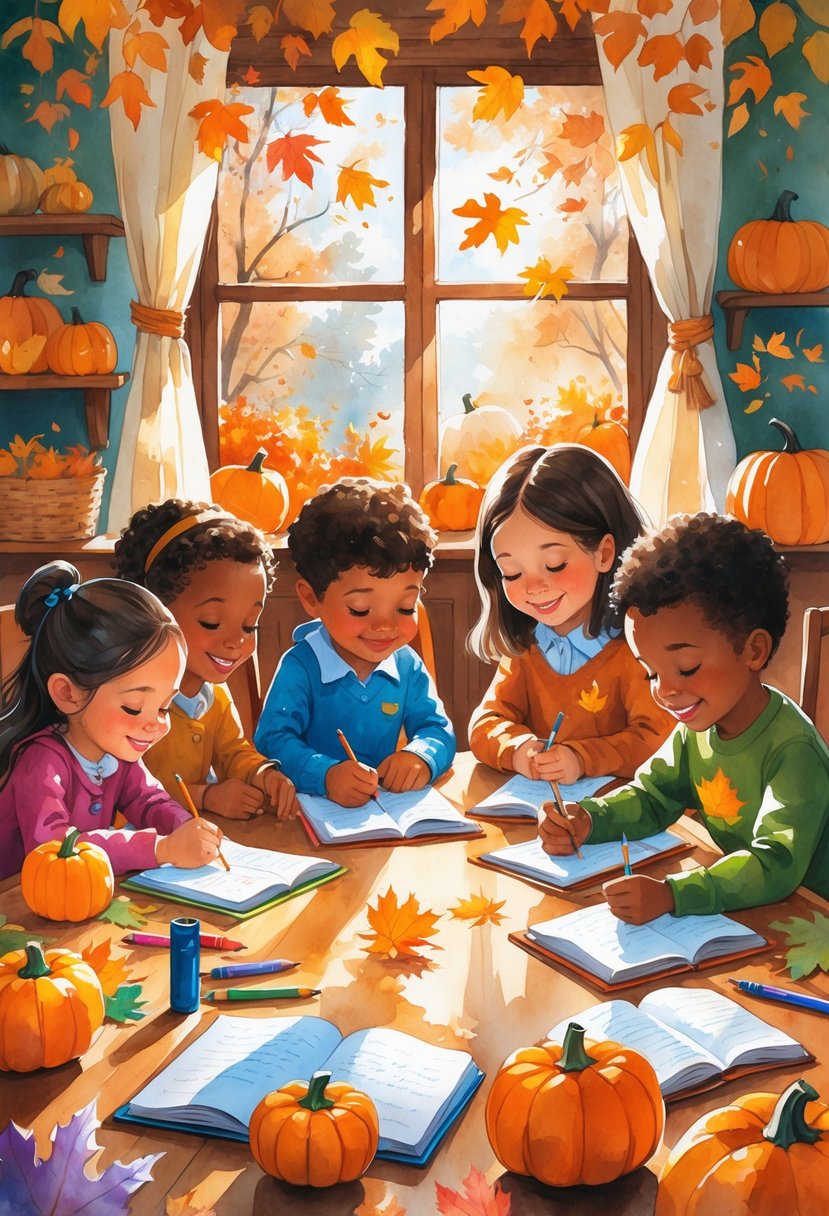
Printable thankfulness journals are a great way to help kids build a daily gratitude habit. These journals mix faith-based prompts with simple activities that get kids thinking about God’s blessings.
Look for Christian Thanksgiving journal printables with devotional activities for families. They’re a nice way to encourage thankfulness and bring everyone together spiritually.
Most journals have Bible verses, prayer prompts, and reflection questions. Kids can jot down three things they’re grateful for each day or just draw little pictures of things that made them smile.
Gratitude worksheets for kids are good for mindfulness and positive thinking. They usually have space for both words and artwork, so even non-writers can join in.
Use these journals during family devotion time or as a quiet wind-down before bed. The structure makes it easier for kids to stick with a gratitude practice, even after Thanksgiving is over.
Some journals come with seasonal designs—fall colors, pumpkins, the whole vibe. Others focus on gratitude all year, with scripture about giving thanks and noticing God’s goodness.
The printable format lets you adjust for your child’s age or writing level. Print extra copies or laminate a few pages and use dry-erase markers for repeat use.
Bible-Based Thanksgiving Song and Dance
Music and movement just make learning stick, especially when it comes to Bible truths about gratitude. Teach kids easy songs that celebrate God’s blessings and add some fun dance moves—they’ll love it.
Check out Christian Thanksgiving songs for kids like “Apple Pie Praise.” These catchy tunes mix thankfulness with a bit of silliness and lots of God’s goodness. Preschoolers and toddlers especially get into it.
Find creation songs and Bible-based music set to tunes the kids already know. That way, they can sing along right away—no learning curve.
Add simple hand motions or dance steps. Maybe clap for God’s love or stretch arms up high when singing about creation. It doesn’t have to be fancy to be fun.
Try teaching a song based on Psalm 100 or another thanksgiving passage. Connecting movement to scripture helps kids remember the verses and the meaning behind them.
Make up your own dance moves for classic hymns like “Count Your Blessings.” Let the kids come up with their own ideas for parts of the song—they’ll surprise you.
Group singing and dancing works great for Sunday school or children’s church. Or just use these songs as a break between other activities.
Record the kids singing their favorite thanksgiving songs and share with parents. It’s a sweet way to make memories and reinforce the gratitude message.
The Importance of Thanksgiving in the Bible

Thanksgiving shows up everywhere in the Bible. So many verses point to gratitude as a core part of faith.
When kids learn about biblical thankfulness, they start to see how it deepens their relationship with God and helps them spot His blessings—big and small—in everyday life.
Biblical Verses About Gratitude
The Bible talks a lot about gratitude and its place in your spiritual journey. 1 Thessalonians 5:18 says, “give thanks in all circumstances; for this is God’s will for you in Christ Jesus.”
Psalm 100:4 urges you to “enter his gates with thanksgiving and his courts with praise; give thanks to him and praise his name.” Thanksgiving really does open the door to worship, doesn’t it?
Ephesians 5:20 tells you to give “thanks to God the Father for everything, in the name of our Lord Jesus Christ.” The Bible verses about thanksgiving and appreciation point to God’s goodness through everyday kindness and provision.
Colossians 3:17 says, “whatever you do, whether in word or deed, do it all in the name of the Lord Jesus, giving thanks to God the Father through him.”
Why Children Should Learn Thankfulness
When you teach children biblical gratitude, you help lay the groundwork for lifelong faith and contentment. If kids see God as the source of their blessings, they start to develop humility and real appreciation for what they have.
Grateful kids notice God’s care in the small stuff—food on the table, a safe home, family around them. Bible lessons that build gratitude at Thanksgiving let children grow thankful hearts through Scripture and a bit of honest reflection.
When children practice thankfulness, they often become more generous and kinder to others. They start to share what they’ve got and look for ways to help. Biblical gratitude can even shield kids from entitlement and materialism, which, let’s be honest, can sneak in pretty fast these days.
Making Thanksgiving Meaningful for Kids

Prayer turns regular activities into spiritual moments. When you add sharing and reflection, kids connect more deeply with gratitude. These little habits can make any Thanksgiving activity stick in their hearts.
Incorporating Prayer Into Activities
Prayer fits naturally into crafts and group activities. Kick things off with a simple prayer, asking God to help everyone see His blessings.
As you get into crafts, pause for a quick prayer over the supplies. Thank God for the paper, glue, and crayons. Invite kids to pray for whoever might receive what they make.
Before Activities:
- Pray for open hearts to learn
- Thank God for creative abilities
- Ask for patience during crafting
During Activities:
- Pause to thank God for supplies
- Pray for recipients of crafts
- Ask God to bless their work
Wrap up each activity with gratitude prayers. Ask children to thank God for one thing they learned or made. Thanksgiving Bible stories can give you some great ideas for prayer, too.
Keep prayers short and simple. Use words kids understand, and let them take the lead when they’re ready. It doesn’t need to be fancy—just honest.
Encouraging Sharing and Reflection
Set aside intentional moments for kids to open up about their thoughts and feelings. Instead of sticking with broad questions, try asking what they’re grateful for—get specific.
After crafts, gather everyone for a sharing circle. Let the kids hold up their finished projects and talk about what they learned.
This hands-on approach can really help connect the activity to something deeper. Sometimes, a simple question sparks a heart-level reflection.
Effective Reflection Questions:
- What surprised you about God’s goodness?
- How did this activity help you feel thankful?
- What blessing do you want to tell others about?
Try out gratitude activities that get kids talking. Gratitude journals work well too—let them write or draw what they’re thankful for.
Give everyone a chance to join in, but don’t force it. Some kids just like to draw their feelings, while others are eager to speak up. It’s important to respect those differences and gently encourage each child.
Put their reflections on display. When kids see their own thoughts valued, they’re way more likely to engage next time.
Follow us on Social Media!
I’m Nina, and I’m very passionate about spirituality. Exploring the depths of the soul and connecting with the divine has always been my source of inspiration. Join me on a journey of self-discovery and inner peace through my writing.

